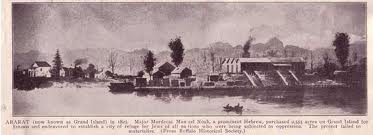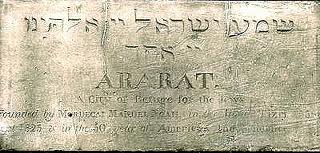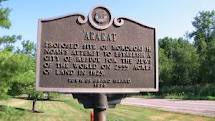 Manuel Mordecai Noah, an American Jew born in Philadelphia in 1785, did much world travelling in his day — he visited Europe numerous times and was the US consul to Tunis — but it is perhaps the tale surrounding his travels from New York City to the upper reaches of New York State in 1825 that has the greatest power to fascinate modern readers.
Manuel Mordecai Noah, an American Jew born in Philadelphia in 1785, did much world travelling in his day — he visited Europe numerous times and was the US consul to Tunis — but it is perhaps the tale surrounding his travels from New York City to the upper reaches of New York State in 1825 that has the greatest power to fascinate modern readers.
The Buffalo and Erie County Historical Society building at 25 Nottingham Court (off Elmwood Ave. near the Knox-Albright Gallery) is an elegant architectural remnant of the 1901 Pan American Exposition. Inside, visitors will find a remnant from an earlier era: the cornerstone for Ararat, an envisioned city for the world’s Jews that Mordecai Manuel Noah attempted to found on Grand Island, an isle in the Niagara River.
The little-known story of Ararat is one of the most fascinating chapters of the early history of Jews in North America. In the Biblical account of the flood, Ararat is the mountain where Noah’s ark came to rest when the waters receded. Our story involves another man named Noah and another place called Ararat, situated in a Buffalo suburb, about 100 miles from Toronto near the international border between Canada and the United States.
 In 1825, Grand Island was a largely uninhabited and heavily wooded island in the Niagara River. Noah, an accomplished journalist, playwright, author, politician, judge, sheriff, diplomat and philanthropist, dreamed of establishing a community called Ararat on a Manhattan-sized tract of land on Grand Island as a “city of refuge” for all the Jews of the world, and principally by “emigrants of the Jewish religion from Europe.”
In 1825, Grand Island was a largely uninhabited and heavily wooded island in the Niagara River. Noah, an accomplished journalist, playwright, author, politician, judge, sheriff, diplomat and philanthropist, dreamed of establishing a community called Ararat on a Manhattan-sized tract of land on Grand Island as a “city of refuge” for all the Jews of the world, and principally by “emigrants of the Jewish religion from Europe.”
An early, ardent Zionist, Noah never surrendered the messianic dream of a return to Palestine. In the meantime, however, he felt that his oppressed Jewish brethren around the globe deserved a “temporary and provisionary” home where they could live with freedom and dignity. He informed international Jewish leaders that “an asylum is prepared and hereby offered to them (the Jewish people) where they can enjoy that peace, comfort and happiness which have been denied to them through the intolerance and misgovernment of former ages.”
 What could have motivated such a singular and grand gesture? In the book Jewish Pioneers and Patriots, author Lee Friedman described Noah as “a Quixotic medley of the theatrical, the ridiculous and the wise, a man of fine presence, real eloquence, but obsessed by his own importance and the conviction that he was a great genius and a personage of vast importance to his country; a dreamer of dreams, a visionary and an enthusiast, and yet withall, in spite of his foibles, a man of action, talent and ability — a curious, pompous, likeable combination of contradictions.”
What could have motivated such a singular and grand gesture? In the book Jewish Pioneers and Patriots, author Lee Friedman described Noah as “a Quixotic medley of the theatrical, the ridiculous and the wise, a man of fine presence, real eloquence, but obsessed by his own importance and the conviction that he was a great genius and a personage of vast importance to his country; a dreamer of dreams, a visionary and an enthusiast, and yet withall, in spite of his foibles, a man of action, talent and ability — a curious, pompous, likeable combination of contradictions.”
There were some, of course, who did not find him so likeable. At least one rabbinical authority branded him a charlatan and — according to a Buffalo newspaper of the day — “demanded authentification of the prophetic text which points out a marsh in North America as the spot for re-assembling the scattered remains of Israel.”
Noah envisioned levying a tax of “three shekels in silver per annum” on all Jews for the maintenance of Ararat. He also wanted to establish a modern Sanhedrin “in which the affairs of the Jewish nation will be principally discussed.” His model was the 70-person Sanhedrin, the supreme court of the ancient Jewish nation, as well as the modern counterpart that Napoleon Bonaparte had dramatically reconvened in Paris in 1806, less than two decades earlier.
 Ararat was to be a city of 1,000 acres built on the southeastern section of the six-mile-by-eight-mile island. Noah’s plan was to divide the city into 1,000 even lots and sell them for $100 each to cover the isle’s purchase price. The land certainly was about to rise greatly in value, as Noah had foreseen, because of its proximity to the western terminus of the newly-built Erie Canal.
Ararat was to be a city of 1,000 acres built on the southeastern section of the six-mile-by-eight-mile island. Noah’s plan was to divide the city into 1,000 even lots and sell them for $100 each to cover the isle’s purchase price. The land certainly was about to rise greatly in value, as Noah had foreseen, because of its proximity to the western terminus of the newly-built Erie Canal.
On September 15, 1825, a colorful parade that included a military band and many masons and U.S. officers on horseback wound through the streets of Buffalo. In anticipation of the ceremony in which Noah would dedicate a cornerstone for his dream-city in the wilderness, crowds lined the shores of the Niagara River. However, because the river was too difficult to cross, the historic event was moved at the last minute to St. Pauls’ Episcopal Church in Buffalo. The Buffalo Emporium would headline the story, “Revival of the Jewish Government.”
On this important occasion, Noah wore a self-designed costume of royal ermine and silk, and seemed indifferent to the fact that he was possibly the only Jew in attendance; he was surrounded by his friends and brethren from the Masonic Order. He gave a long speech in which he expounded on the virtues of New York State and the Erie Canal, called on the Jews of the world to gather in his newly-established city of refuge, and rambled on diverse other subjects, including his theory that the American Indians constituted the remnants of one or more lost Hebrew tribes.
The large cornerstone prepared for the dedication ceremony was inscribed: “ARARAT — A City of Refuge for the Jews Founded by Mordecai Manuel Noah, in the month of Tizri 5586, Sept. 1825, & in the 50th year of American independence.”
Without even once setting foot on Grand Island, Noah returned home to New York where he continued to issue proclamations in promotion of Ararat. The cornerstone, which lay exposed in the churchyard for more than half a century thereafter, was the only part of Noah’s dream to become concrete reality. After the failure of his plan, he turned his energies toward the establishment of a Jewish state in Palestine. Today, Grand Island is crisscrossed by bridges and highways; a large Holiday Inn stands on the site of his proposed Jewish Utopia, across the river from what is now Tonawanda.
Noah’s biographer, Isaac Goldberg, claims that Noah emerges from this episode “as an eccentric, surely, but nonetheless as an important pioneer in the story of Zionistic endeavor. If his descendants in the struggle for a Jewish homeland cannot honor his head, they do all honor to his heart.” ♦
© 2007






